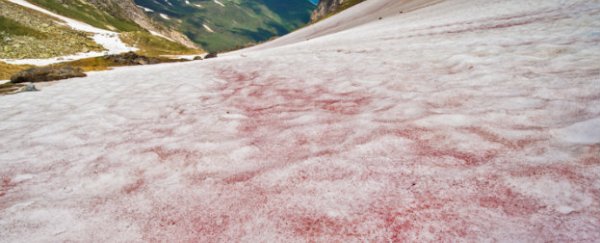If you're a keen mountaineer or live somewhere where it snows, you may have come across streaks or blotches of pink in the snowfall around you. For thousands of years, this mysterious pink snow - also known as watermelon snow - had puzzled explorers and scientists alike, until 19th century Scottish botanist Robert Brown finally figured out that some frost-loving algae have been painting their towns, well, pink.
Brown discovered that a species of algae called Chlamydomonas nivalis was responsible for the bright pink hue of watermelon snow. C.nivalis is a type of snow algae - a group of cold-tolerant algae that thrive on snow and ice. Like the river-dwelling relatives, snow algae contain mostly green pigment, but they're unique in also containing a secondary red pigment. When C.nivalis algae gather in high concentrations in the snow, this red pigment makes it appear pink.
The red pigment also acts as a natural sunscreen, protecting the algae from damaging visible and ultraviolet radiation. It also helps absorb warmth for the algae from the surrounding area.
During the winter months when snow covers the algae, they become dormant. As it gets warmer and the snow melts, nutrients trigger the algae to begin germination. As the algae grows, they can give rise to an 'algal bloom', which causes streams, patches, or small pocket-holes of pink colour to form at the surface of the snow.
Many people report that pink snow sometimes has a faint smell of watermelon, but no one's quite figured out why. And no, it's definitely not edible - the algae are considered toxic to humans.
Snow comes in other colours too - different algae species can make it appear green and occasionally orange. So next time you're in the snow, dig deep with a shovel and see what you can find. Who knows, there might even be yet another weird and wonderful colour of snow waiting to be discovered.
Source: io9, Scientific American
